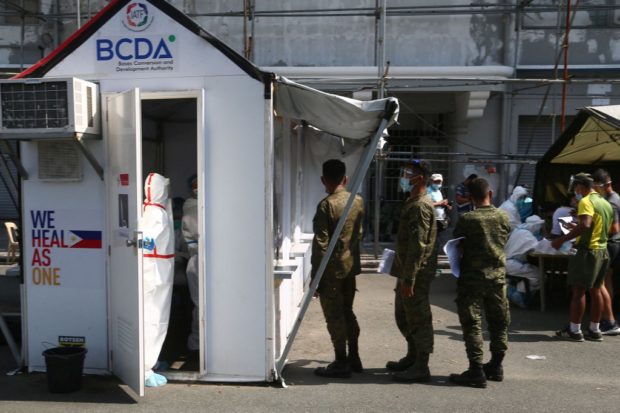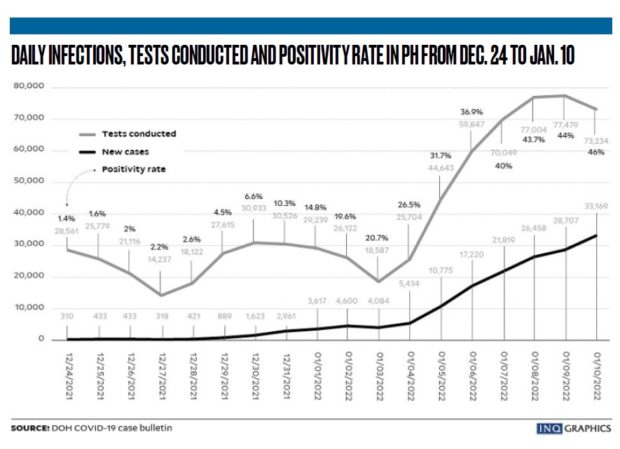Several hospitals full as COVID-19 surge continues for third straight day

Military personnel queue up for coronavirus swab tests outside a gymnasium in Manila on Jan. 7, 2022, as infections driven by the Omicron variant have tripled in the last two days in the nation’s capital. (Photo by Agence France-Presse)
MANILA, Philippines — For the third straight day, the number of new COVID-19 cases in the country broke records after the Department of Health (DOH) on Monday reported 33,169 infections, the highest daily tally since the pandemic started two years ago.
The positivity rate was at 46 percent based on the 73,234 people who were tested on Saturday, the DOH said. This did not include figures from 10 laboratories that failed to submit their data to the COVID-19 Document Repository System.
The DOH said 18,535 or 56 percent of the new infections were in Metro Manila. Calabarzon (Cavite, Laguna, Batangas, Rizal and Quezon) and Central Luzon also reported big numbers of new cases.
The country’s total caseload since the pandemic began was now 2,998,530.
Independent pandemic monitor Octa Research said the COVID-19 positivity rate in the National Capital Region (NCR) has also increased.
Article continues after this advertisement“The positivity rate in the NCR is 50.5 percent as of Jan. 7, 2022, the first time it exceeded 50 percent in the NCR,” OCTA Research fellow Dr. Guido David said in a post on Twitter.
Article continues after this advertisementWhile he noted that this was too high, he said data from the DOH showed that the rate of increase could be slowing down.
“If the increase in positivity rate is slowing down, then the peak in the NCR might occur within the week. Let us hope that is the case,” he said.
With the increase in infections, calls received by the One Hospital Command Center have also spiked to more than a thousand a day, according to the center’s operations manager, Dr. Bernadette Velasco.
Launched in August 2020, the One Hospital Command Center is mandated to facilitate a comprehensive and coordinated response to the pandemic by ensuring effective and efficient health facility referral in Metro Manila and nearby areas.
Velasco said that in December last year, the country’s COVID-19 referral hotline received an average of 150 to 200 calls a day.
“Since the start of the year, we saw a sudden increase in cases. We now receive more than 1,000 calls a day,” she said in a radio interview.
But Velasco said most of the calls, unlike during the height of the previous surge, were from mild and asymptomatic patients.
Hospital occupancy
The surge in COVID-19 cases this year has filled many hospitals especially around Metro Manila.
The Philippine General Hospital (PGH) has decided to temporarily close its outpatient department for walk-in consultations and unscheduled face-to-face visits as the number of health-care workers infected with COVID-19 in the facility continued to rise.
At the Laging Handa briefing, special adviser of the National Task Force Against COVID-19 Ted Herbosa said that more than 500 doctors, nurses and medical technologists of PGH had tested positive for COVID-19.
He said the COVID-19 wards in NCR were now 65-percent occupied.
Monday’s DOH bulletin showed that 38 percent of the country’s intensive care unit (ICU) beds were occupied, while 41 percent of isolation beds and 17 percent of mechanical ventilators were in use. In NCR, 52 percent of ICU beds, 54 percent of isolation beds and 25 percent of the ventilators were in use.
Pasay City General Hospital, in an announcement on Jan. 5, said it reached its full capacity for COVID-19 ICU beds, ward beds and emergency isolation rooms.
Ospital ng Muntinlupa has also reached its maximum capacity on Sunday, according to the city’s public information office.
In San Juan City, the bed occupancy rate in Kalinga Center reached 115.24 percent, or 121 of the 105 capacity. At the San Juan Medical Center, 56 beds out of the 75 available, or 74.66 percent, were occupied.
In the City of Manila, the six district hospitals reached more than half of their bed capacity for COVID-19 cases.
Unprecedented
Ospital ng Maynila, Ospital ng Sampaloc, Justice Jose Abad Santos General Hospital, Gat Andres Bonifacio Medical Center, Ospital ng Tondo and Sta. Ana Hospital have a total of 494 COVID beds. As of Jan. 9, 251 of these, or 51 percent, were already occupied.
In two northern Manila hospitals, the number of infected health-care workers now far outpace the number of sick nonmedical staff—an unprecedented new trend that showcased Omicron’s contagiousness.
Fortunately, all of the health-care workers were vaccinated and thus exhibited only mild to moderate symptoms, according to the spokespersons of East Avenue Medical Center in Quezon City and Jose N. Rodriguez Memorial Hospital and Sanitarium (Tala Hospital) in Caloocan City.
New quarantine rule
Health-care workers, meanwhile, have also opposed the new government policy shortening the isolation and quarantine protocols for medical workers with exposure to COVID-19 cases.
“[This] will pose further danger to the health and safety of health workers as well as the patients. This will also further accelerate the proliferation and spread of infection,” the Alliance of Health Workers (AHW) said in a statement.
The group said the new policy was “inhumane and unjust” to health workers who risk their lives battling the infectious and deadly coronavirus.
The group stressed that health workers with high-risk exposure to COVID-19, with or without symptoms, should be quarantined and undergo free, regular and mandatory reverse transcription-polymerase chain reaction (RT-PCR) test.
AHW called on the government to implement a mass hiring of regular health workers with living wage, stressing that the solution to sustaining the country’s health-care capacity was by preventing public hospitals from getting overwhelmed.
The Filipino Nurses United also criticized the new policy on quarantine and isolation for health-care workers, stressing that it compromised their own health and safety.
